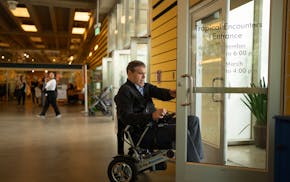The bus rapid transit development along Cedar Avenue is rolling along, with station construction expected to start this spring, even as officials search for $11.9 million to plug a gap in the $76 million budget for the first phase of the project.
The money shortage became apparent in late 2008 after Dakota County completed an engineering study that gave clearer estimates of costs for improving and expanding Cedar Avenue.
But Commissioner Will Branning said he is confident the county will find the funding through federal, state or possibly local sources in order to complete the transit project that he touts as light rail on rubber wheels.
"It's the number one project in Dakota County, so we'll all work to make it happen," Branning said.
Just getting this far has been a decades-long effort, he said, noting that a variety of cities, counties and transit providers have been working together to build bus rapid transit systems on both Cedar and Interstate 35W from Lakeville to downtown Minneapolis.
Although Metro Transit, not Dakota County, is coordinating the effort on the interstate highway, both systems will operate basically the same way once they open. Buses will run in designated lanes, sometimes the high occupancy or toll lanes and sometimes the shoulder, to shuttle people between Dakota County and downtown Minneapolis. The buses will stop at stations or park-and-rides along the route, much like a light-rail train.
Both the 35W and Cedar projects got jump-starts through a $133 million federal grant with a $50 million state match awarded under an Urban Partnership Agreement for multiple transit projects in the metro area. The rest of the Cedar funding has been cobbled together from federal, state and local sources, including the quarter-cent sales tax established in 2008 to pay for transit projects.
"We have 13 different funding sources for this project and each has different timelines and restrictions or requirements, so it's quite a project to pull together financially," Dan Krom, the county transit manager, said.
And the deadlines for some of that funding -- particularly the money from the UPA -- have been driving the expansion and construction of new park-and-ride and transit stations.
Bids have been accepted for an expansion of the Apple Valley Transit Station, and the Minnesota Valley Transit Authority could award a contract this week for construction to begin this spring.
Plans for that station, currently a surface lot served by MVTA buses, include a platform, a skyway to cross Cedar Avenue, and a parking garage with three levels that would be open by fall 2009. The county has also pitched that station as a potential beneficiary of federal stimulus money. With another $3 million, there could be an additional level on the parking garage, bringing its capacity from about 750 to about 950 vehicles.
Another transit station at Cedar Grove in Eagan is also expected to be under construction this year, opening some time in 2010 with added bus service. Like the Apple Valley station, the Cedar Grove stop will include a skyway over Cedar Avenue to allow passengers to catch buses from the median once designated bus lanes are constructed.
And a park-and-ride in Lakeville, with six express bus trips for commuters in the mornings and evenings, will be opening in fall 2009, as well.
Sam O'Connell, a transit specialist for Dakota County, said the new stops will give residents a taste of what riding on the line will be like once the Cedar Avenue bus rapid transit is fully developed.
"Residents will be able to see the project really come to life this year," O'Connell said.
Katie Humphrey • 952-882-9056
Anderson: For opener, fishing will be fantastic — and catching will be great

As unsolved Minneapolis homicides stack up, families of victims wait for justice

Minneapolis residential property taxes could rise steeply in 2025

'I'm a living miracle.' Tommies athlete goes from broken bones to broken record

